INTRODUCTION
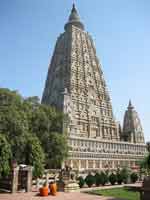 |
Bodh Gaya is situated at a distance of about 105kms from Patna and 15kms south of Ganga.The life of Gautam Buddha, the founder of Buddhism, is associated with the town of Bodh Gaya.It is one of the holiest cities of Buddhist faith. Tread reverently along the ancient path, at the Mahabodhi tree where something strange happened, realization of truth or spiritual illumination. The tree still appears to radiate an aura of abiding serenity, spiritual solitude and peace. This is one of the four greatest places of Buddhist pilgrimage to which the devout Buddhists from all over the world congregate.Bodh Gaya is a place which should be visited or seen by a person of devotion and which would cause awareness of the nature of impermanence. Apart from a pilgrim centre Bodh Gaya is also an important center for the study of Buddhism.
HISTORY
From ancient period the history behind this place s associated with Buddhism. During the 7th century BC when small kingdoms where sprouting up in India Bodh Gaya and the surrounding areas came under this category. However Bodh Gaya got itself a record in the history only during the 6th century BC. It came into limelight in 6th century BC, when the local prince Gautam Buddha who was initially known as Siddharth gave up all material possession and, after practicing rigorous act of self-mortification for years, attained Enlightenment or Nirvana under a Bodhi (Bo) tree and started spreading the message of love and peace. Later the place where Gautama Buddha was enlightened got highlighted by the great Mauryan ruler King Ashoka who built a shrine here and soon was known all over the world as the Mahabodhi temple.
LOCATION
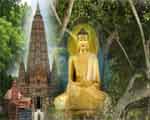 |
BEST SEASON
The ideal time to visit Bodh Gaya is between the months of December to March.
FAIRS AND FESTIVALS
BUDDHA JAYANTHI
EVesak is the birthday of the Buddha and the most important festival in Buddhism. On the first full moon day in May, Buddhists all over the world celebrate the birth, enlightenment and death of the Buddha in a single day. The name "Vesak" comes from the Indian month of that name in which it is held. The Buddha Birth Day Festival is a celebration of the birth of Sakyamuni Buddha, who was born over 2,500 years ago in India as Prince Siddartha. This annual Brisbane event is held each year in the Southbank Parklands and the organizers claim it to be the largest event of this type in the world. Judging by the crowds I wouldn�t disagree with the claim. The aim of the festival is to promote peace and harmony in our society and multi-faith interaction amongst people from diverse backgrounds. This fun 3 day event included multicultural performances, displays, various activities, and a large international food fair.
PILGRIIMAGE ATTRACTION
MAHABODHI TEMPLE
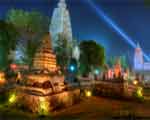 |
The famous Mahabodhi Temple has been restored and rebuilt over the centuries. Set among verdant lawns this giant pyramidal sandstone structure goes to a height of 54meters and is visible for miles around. The walls are carved with various aspects of Buddhism. The sandum sandorum has a colossal golden Buddha. A chamber at the top houses a figure of Mayadevi, the Buddha's mother. An ancient stone railing surrounds the temple on three sides. The railing dates to 100BC and is the oldest of the excavated evidence in Bodhgaya.The temple is said to stand at the site of the original 3rd century BC temple built by the Maurayan Emperor,Ashoka.The temple was rebuilt in the 7th century AD by the Pala Kings of Bengal.Hiuen Tsang,the Chinese scholar,pilgrim,refers to having seen it. Destroyed by the Muslim invaders in the 12th century, the temple was restored by the Burmese kings in the 14th century, flooded and buried under silt till the 9th century. The Mahabodhi Temple has now been declared as a World Heritage site by the UNESCO.
BODHI TREES
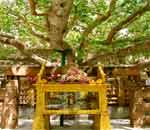 |
AGautama Buddha spent the first week after his enlightenment under the Bodhi tree, towards the left in the Mahabodhi Temple complex. It is believed that the original tree sprang up the day the Buddha was born. The tree was destroyed and replanted of at least five times. The present tree grew from a sapling brought from a tree in Anuradhapura in Sri Lanka, which had been planted by Emperor Ashok's son, Mahendra in 3rd century BC.The holy tree which is surrounded by small beautiful carved decorative stupas and chaityas form a canopy over the seven sacred shrines. People pray, meditate and submit before the Bodhi tree, making a wish or in thanksgiving.
VULTURE PEAK
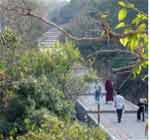 |
Vulture Peak close to Bodh Gaya is situated at an altitude of about 2354 ft.This the place where Buddha often used to meditate. Most of the pilgrims visiting this place climb up the steps which comes upto nearly 1500 steps whereas those who are not able to take a motorized chair lift to the top.
VAJRASANA
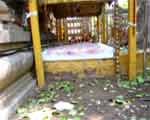 |
Vajrasana, the seat of stability. Buddha supposed to have say in meditation gazing east, under the Bodhi Tree, where the Vajrasana, the stone platform is kept.
CHANKARAMANA
This marks the sacred spot of the Buddha's meditative perambulations during the third week after pious enlightenment. It is believed that wherever the Buddha put his feet lotus sprang up.
ARIMESHLOCHANA
It is believed that the Buddha spent one week here looking towards the great Mahabodhi Tree out of gratitude, without twinkling his eyes.
RATNAGAR
The Buddha spent one week here, where it is believed that five colours came out of his body.
TAPT KUND
Tapt Kund, a natural spring situated above the riverbank is supposed to be the holy abode of Lord Agni.The temperature of the water is always quite hot and a holy dip in this helps the devotees to come out of their sin and imparts a new life and energy. Apart from its therapeutic beneficial this hot water spring in the midst of snowy peaks of Himalayas is quite a wonderful.
SHOPPING
Bodh Gaya being a spiritual place has nothing much to shop however there are few shops here and there selling decorative items, associated with Buddhism. Also available are a wide choice of statues of Buddha made of metals and sandalwood.
EAT OUTS
1.Sujata Hotel - near the Mahabodhi Temple where you get Indian, Continental, and South-East Asian cuisine. ACCOMMODATION1.ROYAL RESIDENCY HOTEL Dumuhan Road, Bodhgaya, Dist. Gaya-824231, Bihar 2.LOTUS NIKKO HOTEL Bodhgaya-824231 Dist. Gaya, Bihar 3.TOKYO VIHAR HOTEL Opp. Japneis Temple, Mastipur Road, Bodhgaya, Gaya-824231, Bihar 4.MAHAMAYA HOTEL Near Mahabodi Temple, Bodhgaya, Dist. Gaya-824231 5.SUJATA HOTEL Bodhgaya, Distt. Gaya-824231, Bihar, India 6.Delta International Hotel Deltamore, Domuhan Bodhgaya Bihar-824231 7.TAJ DARBAR Bodhgaya, Dist. Gaya-824231, Bihar, India 8.Hotel Shashi International Near Bhutan Temple, Mastipur Bodhgaya 9.Siddhartha International Station Road, Gaya City Bodhgaya |
Travel Guide
Travel Information
| |||||||||||||||||||||||||||||||||||||||
GETTING THERE
BY AIR
Gaya airport is located at a distance of 13 km from Bodhgaya and Patna, 105 kms away from Bodhgaya. Patna airport is connected to Delhi, Mumbai, Kolkatta, Lucknow and Ranchi while Gaya airport is a smaller International airport. Hire a cab to reach Bodhgaya from either of the airports.
BY RAIL
The nearest Railway station is Gaya located 16 kms away. Gaya is a major railhead and is connected to the rest of India.
BY ROAD
For Buddhist pilgrims, the best option for travel is to reach Patna or Gaya, either by air or train, and then travel to Bodhgaya. Regular direct bus services are available from Gaya, Patna, Nalanda, and Varanasi.


